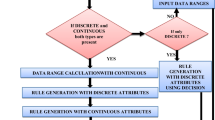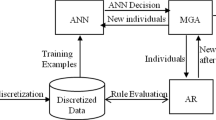Abstract
Classification is one of the foremost machine learning tasks in this modern era. Neural Network (NN) is one of the powerful classification techniques. NN can achieve high classification accuracy on highly imbalanced and complex datasets, but lacks in explanation of its reasoning process which limits its applicability in various domains which require transparent decision along with good accuracy. There are some techniques which extract rules from NN and make it transparent; however, attribute pruning, rule pruning and class overlap algorithms are not sufficiently effective. Therefore, this paper proposes a rule extraction algorithm, called Transparent Rule Extraction using Neural Network (TRENN) to convert NN into white box with greater emphasis on attribute pruning and rule pruning. The proposed TRENN is a pedagogical approach and an extension of one of the existing algorithms named Rule Extraction from Neural Network using Classified and Misclassified data (RxNCM). The proposed TRENN extends the RxNCM with sequential floating backward search for feature and rule selection to improve the comprehensibility of the generated rules. Besides, the proposed TRENN uses probabilistic approach for the treatment of class overlapping problem in the rule updating phase instead of reclassification used in RxNCM where the overlap may persist. Experiments are conducted with eight real datasets collected from the UCI repository. Performance of the TRENN is measured with Precision, Recall, FP-Rate, F-measure, and local and global comprehensibility. It is observed from the experimental results that TRENN performs better than Re-RX, RxNCM and RxREN.









Similar content being viewed by others
References
Augasta MG, Kathirvalavakumar T (2012) Reverse engineering the neural networks for rule extraction in classification problems. Neural Process Lett 35:131–150
Biswas SK, Chakraborty M, Purkayastha B, Roy P, Thounaojam DM (2017) Rule extraction from training data using neural network. Int J Artif Intell Tools 26:1–26
Bologna G, Hayashi Y (2018) A comparison study on rule extraction from neural network ensembles, boosted shallow trees, and SVMs. Appl Comput Intell Soft Comput 2018:1–20
Bondarenko A, Aleksejeva L, Jumutc V, Borisov A (2017) Classification tree extraction from trained artificial neural networks. Proc Comput Sci 104:556–563
Botari T, Izbicki R, Carvalho A (2019) Local interpretation methods to machine learning using the domain of the feature space. ECML PKDD 2019:241–252
Caruana R, Niculescu-Mizil A (2007) An empirical comparison of supervised learning algorithms. In: ICML ’06 proceedings of the 23rd international conference on machine learning, pp 161–162
Cohen S, Rokach L, Maimon O (2007) Decision-tree instance-space decomposition with grouped gain ratio. Inf Sci 177:3592–3612
Craven M, Shavlik J (1996) Extracting tree-structured representations of trained networks. Adv Neural Inform Process Syst NIPS 8:24–30
Dam HH, Abbass HA, Lokan C, Yao X (2008) Neural-based learning classifier systems. IEEE Trans Knowl Data Eng 20:26–39
Gupta A, Park S, Lam SW (1999) Generalized analytic rule extraction for feedforward neural networks. IEEE Trans Knowl Data Eng 11:985–991
Han J, Kambler M (2001) Data mining: concepts and techniques. Morgan Kaufmann, San Francisco
Hruschka ER, Ebeckenb NFF (2006) Extracting rules from multilayer perceptrons in classification problems: a clustering-based approach. Neurocomputing 70:384–397
Iqbal RA (2012) Eclectic rule extraction from neural networks using aggregated DTs. In: IEEE, 7th international conference on electrical and computer engineering (ICECE), pp 129–132
Jivani K, Ambasana J, Kanani S (2014) A survey on rule extraction approaches based techniques for data classification using neural network. Int J Futur Trends Eng Technol 1:4–7
Kaikhah K, Doddmeti S (2006) Discovering trends in large datasets using neural network. Appl Intel 29:51–60
Karim A, Zhou S (2015) X-TREPAN: a multi class regression and adapted extraction of comprehensible decision tree in artificial neural networks. Comput Sci Inform Technol 5:37–54
Kaviani P, Dhotre S (2017) Short survey on Naive Bayes algorithm. Int J Adv Res Comput Sci Manag 4:607–611
Lu H, Setiono R, Liu H (1995) NeuroRule: a connectionist approach to data mining. In: Proceedings of the 21st VLDB, pp 478–489
Mann AK, Kaur N (2013) Survey paper on clustering techniques. Int J Sci Eng Technol Res IJSETR 2:803–806
Mantas CJ, Puche JM, Mantas JM (2006) Extraction of similarity based fuzzy rules from artificial neural networks. Int J Approx Reason 43:202–221
Mashayekhi M, Gras R (2015) Rule extraction from random forest: the RF+HC methods. Springer International Publishing, Switzerland, pp 223–237
Odajimaa K, Hayashi Y, Tianxia G, Setiono R (2008) Greedy rule generation from discrete data and its use in neural network rule extraction. Neural Netw 21:1020–1028
Sestito S, Dillon TS (1992) Automated knowledge acquisition of rules with continuously valued attributes. In: 12th international conference on expert systems and their applications, pp 645–656
Setiono R, Liu H (1995) Understanding neural networks via rule extraction. In: 14th international joint conference on artificial intelligence, pp 480–485
Setiono R, Liu H (1996) Symbolic representation of neural networks. IEEE Comput 29:71–77
Setiono R, Kheng W (2000) FERNN: an algorithm for fast extraction of rules from neural networks. Appl Intell 12:15–25
Setiono R, Baesens B, Mues C (2008) Recursive neural network rule extraction for data with mixed attributes. IEEE Trans Neural Netw 19:299–307
Sharma AK, Shani S (2011) A comparative study of classification algorithms for spam email data analysis. Int J Comput Sci Eng 3:1890–1895
Shridhar M, Parmar M (2017) Survey on association rule mining and its approaches. Int J Comput Sci Eng 5:129–135
Sing V, Midha N (2015) A survey on classification techniques in data mining. Int J Comput Sci Manag Stud 16:9–12
Author information
Authors and Affiliations
Corresponding author
Ethics declarations
Conflict of interest
Abhinaba Dattachaudhuri declares that he has no conflict of interest. Saroj Kr. Biswas declares that he has no conflict of interest. Manomita Chakraborty declares that she has no conflict of interest. Sunita Sarkar declares that she has no conflict of interest.
Ethical approval
This article does not contain any studies with human participants or animals performed by any of the authors.
Additional information
Communicated by Vladik Kreinovich.
Publisher's Note
Springer Nature remains neutral with regard to jurisdictional claims in published maps and institutional affiliations.
Rights and permissions
About this article
Cite this article
Dattachaudhuri, A., Biswas, S.K., Chakraborty, M. et al. A transparent rule-based expert system using neural network. Soft Comput 25, 7731–7744 (2021). https://doi.org/10.1007/s00500-020-05547-7
Published:
Issue Date:
DOI: https://doi.org/10.1007/s00500-020-05547-7




